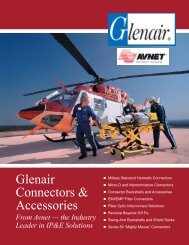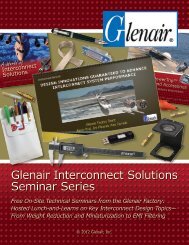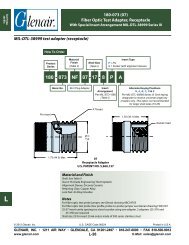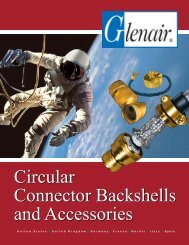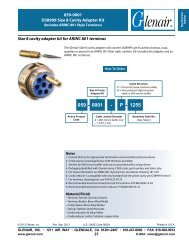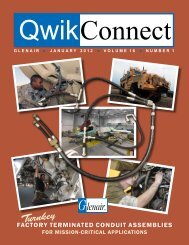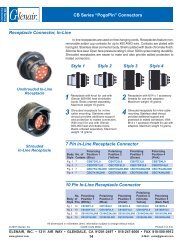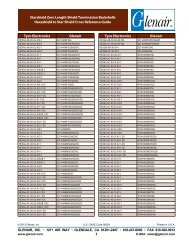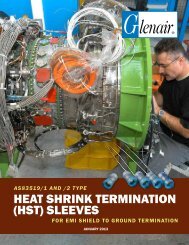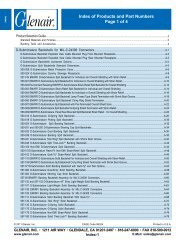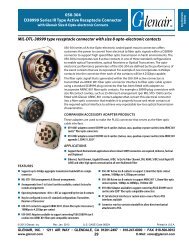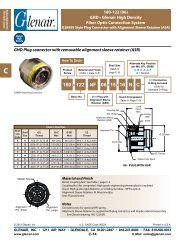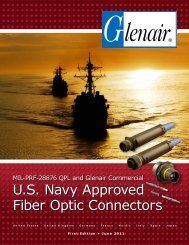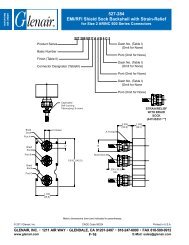April 2007 - Glenair, Inc.
April 2007 - Glenair, Inc.
April 2007 - Glenair, Inc.
Create successful ePaper yourself
Turn your PDF publications into a flip-book with our unique Google optimized e-Paper software.
QwikConnect<br />
GLENAIR APRIL <strong>2007</strong> VOLUME 11 NUMBER 2<br />
In This Issue:<br />
A Strain-Relief Revolution:<br />
The <strong>Glenair</strong> Swing-Arm<br />
Takes To the Sky<br />
QwikConnect · <strong>April</strong> <strong>2007</strong><br />
1
To Most People<br />
It's Just a Strain Relief<br />
Most customers have a simple expectation<br />
when they go shopping for safety-critical<br />
interconnect components: they want fast and<br />
ac cu rate service. <strong>Glenair</strong> ad dress es this<br />
most basic customer requirement in several<br />
different ways. First and foremost, by providing<br />
im me di ate access to our technical in for ma tion<br />
and product documentation: whether you prefer<br />
an offi ce visit, the telephone, the Internet, a<br />
CD or a printed catalog, <strong>Glenair</strong> is ready with<br />
answers to your most complex ques tions and<br />
design challenges. Secondly, <strong>Glenair</strong> stocks<br />
thou sands of popular catalog prod ucts for those<br />
To <strong>Glenair</strong><br />
It's a Promise<br />
situations when even a two or three week leadtime<br />
is just too long. We stock over 60,000<br />
in ter con nect components—bagged and tagged<br />
and ready for immediate shipment. And for<br />
those sit u a tions when a cus tom ized solution is<br />
required, our engineers are fully versed in all<br />
aspects of in ter con nect system design: from<br />
shielding against EMI, to reducing weight and<br />
con nec tor package size, to stopping corrosion<br />
and other forms of en vi ron men tal damage.<br />
You have a simple expectation: fast and<br />
ac cu rate service. At <strong>Glenair</strong>, we're ready to<br />
give you exactly that. It's a prom ise.<br />
1211 Air Way<br />
Glendale, California 91201-2497<br />
Telephone: 818-247-6000 · Facsimilie: 818-500-9912 · EMail: sales@glenair.com<br />
United States · United Kingdom · Germany · N o r d i c · France · Italy · Spain · Japan<br />
www.glenair.com
CoverStory<br />
Revolutions Never Turn Back,<br />
But They Sometimes Take<br />
Very Acute Angles<br />
I<br />
n the early 1990s, <strong>Glenair</strong> was tapped to solve a<br />
major problem on the F-22. Program engineers<br />
were looking to reduce the weight of interconnect<br />
cables in order to free-up weight for a package of<br />
electronic upgrades in the avionic system. <strong>Glenair</strong><br />
was asked to design a backshell that would reduce<br />
weight by up to 50% while maintaining the strength,<br />
performance and flammability characteristics of the<br />
original metal parts. Program engineers also sought<br />
a dramatically faster method for termination of EMI<br />
shielding. Finally, they asked for a conductive part that<br />
did not require surface plating of the backshell coupling<br />
nut or body, to eliminate scratched parts that were<br />
susceptible to galvanic corrosion.<br />
<strong>Glenair</strong>'s solution to this list of requirements<br />
was nothing short of revolutionary. We designed a<br />
composite thermoplastic strain-relief with an integrated<br />
shield-sock and an internal ground ring. By design,<br />
the interlocking teeth on the internal ring created<br />
such an effective ground-path between the backshell<br />
and the connector, that there was no need to<br />
apply conductive plating to the backshell coupling<br />
nut. The choice of composite plastic answered<br />
the weight reduction requirement, and the shieldsock<br />
was a faster, easier method for EMI shield<br />
termination. More importantly, the product met all<br />
testing requirements for AS85049, including electrical<br />
resistance, vibration, and the full range of shock and<br />
strength tests. Additional F-22 testing was even more<br />
stringent, and included transfer impedance and shielding<br />
effectiveness requirements. The <strong>Glenair</strong> F-22 backshell,<br />
passed every test (relevant test reports available).<br />
Fast forward to the year 2000, an engineer on a<br />
major airframe program presented <strong>Glenair</strong> with a<br />
new challenge: What if we don’t know in advance<br />
the exact route a cable will take as it enters or exits<br />
a box or panel He wondered how he could avoid<br />
downtime waiting for new parts once the fi nal angle<br />
and profi le was determined for each cable clamp in a<br />
harness. Ideally, he wanted to be able to reposition<br />
the angle of the strain-relief “on the fl y.” He also<br />
wanted a strain-relief made of lightweight conductive<br />
materials compatible with a number of different<br />
metals yet to be specifi ed.<br />
This set of requirements eventually led to the<br />
development of the <strong>Glenair</strong> Swing-Arm Strain-Relief<br />
Backshell: a composite thermoplastic connector<br />
accessory based almost entirely on the 440 Series<br />
F-22 parts but with the addition of articulating arms<br />
that quickly adjust and lock into three positions—<br />
straight, 45˚, and 90˚. Although speed of assembly,<br />
weight reduction and versatility were obvious<br />
benefi ts of the Swing-Arm, our launch customer<br />
soon recognized another signifi cant advantage: the<br />
three-in-one product effectively reduced accessory<br />
inventories from 27 part numbers (three angles each<br />
for nine shell sizes) to just nine (one part for each<br />
shell size)—a major cost-saving advantage.<br />
Since its introduction, the <strong>Glenair</strong> Swing-Arm<br />
has evolved into a number of distinct confi gurations<br />
and designs and has now established itself as<br />
a viable EMI/RFI shield termination device for<br />
high reliability military and commercial aerospace<br />
applications.<br />
QwikConnect · <strong>April</strong> <strong>2007</strong><br />
3
CoverStory<br />
Special Features and Benefits of the<br />
Composite Swing-Arm EMI/RFI Strain-<br />
Relief Backshell<br />
<strong>Glenair</strong>’s patented composite Swing-Arm<br />
backshell provides lightweight and corrosion-free<br />
strain-relief for wire bundles and open loom cable<br />
assemblies. The shield-sock version of the product<br />
is also appropriate as a strain-relief and shield<br />
termination device for use with shielded, jacketed<br />
cables. When specifi ed with its integrated shieldsock,<br />
the Swing-Arm offers extremely fast and<br />
reliable termination of EMI shields using industrystandard<br />
banding tools and bands.<br />
Made from high-temperature composite<br />
thermoplastic, these rugged assemblies offer easy<br />
installation, long term durability, and outstanding<br />
weight and cost reduction. Standard features<br />
<strong>Glenair</strong> is the industry leader in the innovative use of<br />
thermoplastics in high-reliability interconnect systems.<br />
include self-locking rotatable coupling nuts, and,<br />
on shield-sock versions, a choice of integrated<br />
nickel/copper or metallized thermoplastic EMI/RFI<br />
braiding for electromagnetic compatibility. The<br />
Swing-Arm technology can also be incorporated<br />
into other EMI/RFI shield termination methods such<br />
as standard banding backshells. All versions have<br />
been performance tested to stringent AS85049<br />
mechanical and electrical standards, as well as<br />
individual air frame test regimens, including the F-22.<br />
We mentioned earlier that the Swing-Arm<br />
achieves a stock-keeping economy of three-to-one,<br />
but there is more to the story. EMI/RFI Shield Sock<br />
versions actually achieve an even greater economy<br />
over traditional strain relief systems when cable<br />
entry sizes are considered. Assuming an average of<br />
fi ve cable entry sizes for each of the nine standard<br />
connector shell sizes, stock keeping units (SKUs) for<br />
backshells drop from 135 SKUs (3 angles X 9 shell<br />
sizes X 5 cable entry sizes) to only nine backshell<br />
SKUs and a handful of support rings. This is due to<br />
the Swing-Arm’s design versatility in accommodating<br />
all of the standard cable entry sizes for each<br />
connector shell size.<br />
In addition to standard "click-style" self-locking<br />
rotatable coupling nuts, Swing-Arm is also available<br />
with <strong>Glenair</strong>-patented G-Load Coupling technology.<br />
The coupling nut spins freely without audible detents<br />
and employs a composite wave washer designed<br />
to apply locking pressure as the part is mounted<br />
to the connector. G-Load Coupling is the perfect<br />
solution for applications which require additional<br />
protection against vibration-related decoupling of<br />
the connector-to-backshell termination. Providing<br />
precise axial alignment and seating of interlocking<br />
teeth, the G-Load prevents decoupling even when<br />
backshells are installed with inadequate torque<br />
values. G-Load Couplers meet all MIL-DTL-38999<br />
and AS85049 performance requirements at low<br />
torque: 25 inch pounds for sizes 08-19 and 35 inch<br />
pounds for sizes 20-25.<br />
The original and most popular Swing-<br />
Arm design is made of injection-molded, hightemperature<br />
composite thermoplastic (PEI)<br />
reinforced with a 30% fi ll of glass fi ber. The material<br />
results in a corrosion-free strain relief backshell<br />
which is 40% lighter than aluminum, 80% lighter<br />
than stainless steel, and can endure 2000+ hours<br />
salt spray. In addition to its resistance to corrosion<br />
and galvanic coupling, the thermoplastic material<br />
also provides exceptional vibration dampening and<br />
superior mechanical properties at temperatures<br />
ranging from -65° to +175° C. Fully compatible<br />
with a broad range of materials including other<br />
composites, aluminum, stainless steel, brass and<br />
more, the Swing-Arm base material is compatible<br />
with all standard fi nish treatments such as cadmium<br />
and electroless nickel.<br />
4 QwikConnect <strong>April</strong> <strong>2007</strong>
Swing-Arm is made of the same composite<br />
material (PEI, 30% glass fi lled) used on other <strong>Glenair</strong><br />
connector, backshell and box products. The <strong>Glenair</strong><br />
family of composite interconnect components<br />
is the most diverse in the industry, and the PEI<br />
material used has been subjected to considerable<br />
performance testing including shock, vibration,<br />
thread strength, and bend moment requirements<br />
of AS85049, MIL-DTL-38999, MIL-STD-167, MIL-<br />
C-901D and MOD 70G Long Duration Shock.<br />
Swing-Arm has demonstrated impressive EMI/RFI,<br />
HIRF and indirect lightning strike performance in<br />
various qualifi cation tests. As noted in the upcoming<br />
sidebar, <strong>Glenair</strong> Swing-Arm is the only backshell to<br />
pass Boeing’s and the FAA’s rigorous qualifi cation<br />
testing for placement on the new 787 Dreamliner.<br />
The Swing-Arm Strain-Relief has passed both the Boeing<br />
Company and FAA's qualification tests.<br />
Swing-Arm can be shipped in two Shield Sock<br />
options: 36 AWG nickel-plated copper or composite<br />
thermoplastic metalized thermoplastic braiding.<br />
Nickel-plated copper braid provides excellent<br />
EMI/RFI protection with good corrosion resistance<br />
and easy grounding termination. Corrosion-free<br />
metallized thermoplastic braids offer equally easy<br />
grounding termination with performance comparable<br />
to the nickel-plated copper—and just half the weight.<br />
The appeal of the Swing-Arm concept makes<br />
new product innovation inevitable. <strong>Glenair</strong> has<br />
already adapted the Swing-Arm concept to the<br />
requirements of our ultra-miniature connector<br />
line, the Series 80 "Mighty Mouse." Fabricated<br />
The <strong>Glenair</strong> patented<br />
Swing-Arm Strain<br />
Relief Backshell is<br />
now available for<br />
"Mighty Mouse" style<br />
connectors. The threein-one<br />
product enables<br />
easy straight, 90° and<br />
45° cable routing<br />
configurations.<br />
from aluminum alloy (or stainless steel for high<br />
temperature applications), the “Mighty Mouse”<br />
version of the Swing-Arm also uses the articulated<br />
arm system to enable straight, 45° and 90°<br />
confi gurations all from the same basic part. The<br />
product provides the same advantage of reduced<br />
stocking requirements, and it is considerably lighter<br />
weight than traditional miniaturized strain-relief<br />
systems.<br />
<strong>Glenair</strong> is also introducing a new banding<br />
adapter Swing-Arm strain relief backshell which<br />
integrates the adjustable Swing-Arm technology<br />
with Band-It Shield Termination. Accommodating<br />
individual or overall shielding, the Banded Swing-<br />
Arm is the lightest weight EMI Swing-Arm design yet.<br />
The Swing-Arm is just one of the many<br />
interconnect innovations available now from<br />
<strong>Glenair</strong>. The product not only meets the application<br />
requirements, performance benchmarks and material<br />
specifi cations required by the Mil-Aero marketplace,<br />
it does so while reducing overall inventory-carrying<br />
costs and assembly times. And when you fi gure<br />
in <strong>Glenair</strong>'s customer service commitment and our<br />
Same Day inventory program, <strong>Glenair</strong> truly has all<br />
the angles covered to support this revolutionary<br />
design's adoption in hi-rel interconnect systems.<br />
Swing-Arm has already been designed-in to a<br />
broad range of military and commercial application<br />
platforms including missile launchers, unmanned<br />
aerial vehicles and commercial and military aircraft.<br />
Even though most of Swing-Arm’s applications to<br />
date have come from the aerospace industry, its<br />
utility is by no means limited to that market. Any<br />
system that requires up to three strain-relief angles<br />
in an open bundle design is ideally suited for the<br />
Swing-Arm revolution.<br />
QwikConnect · <strong>April</strong> <strong>2007</strong><br />
5
CoverStory<br />
How Does the<br />
<strong>Glenair</strong> Swing-Arm<br />
Work<br />
90°<br />
45°<br />
Caution:<br />
Loosen saddle clamps to<br />
allow free cable movement<br />
before adjusting clamp to<br />
angular positions. Form<br />
the cable into the desired<br />
confi guration, then tighten<br />
arms and secure the saddle<br />
clamps.<br />
Conductor<br />
Tape Wrap under Ring<br />
to Ensure Fit<br />
Figure 1<br />
<strong>Glenair</strong> Swing-Arm<br />
Offers Extremely Fast and Trouble-<br />
Free Termination of EMI Shielding:<br />
Overall Braid<br />
from Backshell<br />
Overall Braid from Wire<br />
Bundle (If Applicable)<br />
Optional Tape Wrap<br />
687-207 Split Shield<br />
Support Ring<br />
600-052<br />
Choose Straight, 45° or 90° angle, and<br />
tighten screws to lock arms in place. Leave<br />
the saddle clamp hardware loose.<br />
Next, insert the wire bundle into the<br />
backshell to determine if the braid transition<br />
angle from the backshell to wire bundle is<br />
less than 45º. If it is less than 45°, build up<br />
the wire bundle with tape and re-insert wire<br />
bundle into backshell to support the transition<br />
of overall braid from the backshell to the wire<br />
bundle.<br />
Figure 2<br />
Lacing String or High<br />
Temperature Ty-Strap<br />
Note:<br />
It is recommended that trial samples of appropriate<br />
shield wire bundles be used to determine proper<br />
trim dimensions of the cable (if applicable), and<br />
individual shields and conductors.<br />
6<br />
QwikConnect <br />
<strong>April</strong> <strong>2007</strong>
Shield<br />
Pigtail<br />
Tuck Braid<br />
as Shown<br />
Figure 3<br />
Equally Space Pigtails Around<br />
Ring<br />
Stagger<br />
Solder<br />
Sleeves<br />
Support<br />
Ring<br />
Conductors<br />
Lacing String or High Temperature<br />
Ty-Strap<br />
Lacing String or High Temperature<br />
Ty-Strap<br />
Figure 4<br />
Loosely assembly the adapter to the<br />
connector and push back the backshell braid.<br />
Insert the wire bundle into the adapter and<br />
bottom it against the connector. Holding the<br />
cable, mark or tag the location where the shield<br />
support ring (<strong>Glenair</strong> Part Number 687-207) will<br />
be located. This distance may vary depending<br />
on your technique and the flexibility of the wire<br />
bundle immediately to the rear of the saddles<br />
(Figure 1).<br />
At the marked location, near the shield<br />
support ring, wrap tape around wire bundle for<br />
snug fit of shield support ring (Figure 1). Tape<br />
wrap is optional.<br />
You can then slide the overall braid from the<br />
wire bundle side over the shield support ring,<br />
trimming braid ends and tucking extra braid<br />
underneath itself for a clean appearance.<br />
For pin connectors, slide the backshell<br />
forward, and hand tighten backshell to connector.<br />
Then, evenly space shield pigtails (Figure 3) or<br />
solder sleeve pigtails (Figure 4) around the shield<br />
support ring. Cut the pigtails so that the end of<br />
the pigtails slightly beyond end of shield support<br />
ring.<br />
Bring the shield sock from backshell and<br />
completely cover the pigtails and support ring.<br />
Trim and fold the braid as shown in Figure 2.<br />
Lace tie the shield adjacent to support ring ends.<br />
Install <strong>Glenair</strong>'s Band-it ® band (600-052)<br />
between the lace ties onto the center of the<br />
support ring as shown in Figure 2. The hand<br />
banding tool (600-058) or pneumatic banding<br />
tool (600-067) is used for this banding<br />
process.<br />
Next, you can wrap the shield support ring<br />
assembly with high temperature tape. Place<br />
lacing cord, high temperature tape, or high<br />
temperature plastic Ty-Straps on the braid<br />
transition to the rear of the backshell to secure<br />
the overbraid on wire bundle. If you wish,<br />
you can cover the overbraid with 102-080<br />
braid sock.<br />
Tighten the adapter to the connector using<br />
<strong>Glenair</strong> 600-091 composite hex coupling<br />
torque wrench and related tooling accessories<br />
to established torque values. Secure the strain<br />
relief saddle onto the wire bundle using TG69<br />
soft jaw pliers. Torque the saddle screws to<br />
established values. You can use Teflon tape<br />
wrap or M85049/127 bushing strip as needed<br />
to cushion the braid sock under the saddle<br />
clamps.<br />
With these few steps, your Swing-Arm<br />
strain relief installation is complete!<br />
QwikConnect <br />
· <strong>April</strong> <strong>2007</strong> 7
<strong>Glenair</strong> Swing-Arm:<br />
The Sky's the Limit<br />
The <strong>Glenair</strong> Swing-Arm Strain-Relief Backshell is ideally suited for use in avionics, data<br />
and communications systems, instrumentation, sensing systems, lighting, flap and actuator<br />
controls, landing gear, seat controllers, and in-flight entertainment systems. The Swing-Arm protects<br />
investments in connection systems while enhancing EMI/RFI shielding. Lightweight, rugged,<br />
corrosion free, and versatile, the <strong>Glenair</strong> Swing-Arm is the perfect choice to help both commercial<br />
and defense aircraft manufacturers realize their plans for unparalleled fuel efficiency, dramatic<br />
reductions in assembly times for interconnrect systems, and improved stock-keeping economies.<br />
QwikConnect would like to draw your attention to the evolution of the Swing-Arm by describing<br />
three key applications: The F-22 Raptor, the Bell Helicopter 429 and the new Boeing Company 787<br />
Dreamliner. In the early 1990s, <strong>Glenair</strong> was tapped to solve a major problem on the F-22. Program<br />
engineers were looking to reduce the weight of backshells while maintaining the strength,<br />
performance and flammability characteristics of heavier metal parts. Although it did not<br />
yet have the articulating arm, the Series 440 Composite Shield-Sock Backshell<br />
<strong>Glenair</strong> designed for the F-22 had the same internal<br />
grounding ring with interlocking teeth for positive<br />
Bell Helicopter adopted Swing-Arm for its new Bell 429 model. The<br />
Bell 429 is an advanced, lightweight, twin engine helicopter developed<br />
primarily for emergency medical applications. Similar to the F-22,<br />
weight reduction and performance in harsh conditions were<br />
paramount requirements for connector accessories on the Bell 429.<br />
Swing-Arm has performed so well that Bell is specifying it on additional<br />
new commercial and military programs.<br />
8<br />
QwikConnect <br />
<strong>April</strong> <strong>2007</strong>
Extensive qualification testing with Boeing<br />
and the FAA has established <strong>Glenair</strong> Swing-<br />
Arm’s superiority—it is now fully approved<br />
and specified for accessory needs for all<br />
electrical systems. Lightweight, rugged,<br />
corrosion free, and versatile, the <strong>Glenair</strong><br />
Swing-Arm is the perfect choice to help<br />
commercial aircraft manufacturers realize<br />
their plans for unparalleled fuel efficiency,<br />
dramatically reduced assembly time and<br />
stock-keeping economies.<br />
contact with the connector. Because the ring accomplished complete grounding, there<br />
was no need to plate the backshell, eliminating the possibility of scratching and<br />
corrosion. <strong>Glenair</strong> Series 440 Composites met all testing requirements for F-22, including<br />
electrical resistance, vibration, half-sine shock under AS85049.<br />
Once the articulating arm design was established, Bell Helicopter adopted Swing-Arm for its new<br />
Bell 429 model. The Bell 429 is an advanced, lightweight, twin engine helicopter developed primarily<br />
for emergency medical applications. Quite possibly the most advanced light twin helicopter ever<br />
created, the Bell 429 is both incredibly fast and incredibly light-weight—due in part to the selection<br />
of lightweight composite components throughout the aircraft. The Swing-Arm has contributed<br />
signifi cantly to the 429's landmark performance.<br />
The Boeing 787 Dreamliner is a mid-sized, wide body, twin engine jet airliner currently under<br />
development and scheduled to enter service in May 2008. It will carry between 210 and 330<br />
passengers, and will be more fuel-effi cient than comparable aircraft. It will also be the fi rst major<br />
airliner to use composite material for most of its construction. Extensive qualifi cation testing with<br />
Boeing and the FAA proved out <strong>Glenair</strong> Swing-Arm’s superiority—it is now fully approved and<br />
specifi ed for accessory needs of all electrical systems on this revolutionary aircraft.<br />
QwikConnect ·<br />
<strong>April</strong> <strong>2007</strong> 9
CoverStory<br />
How To Order Swing Arm Backshells<br />
319-064<br />
Composite Swing-Arm Strain Relief<br />
with ASTM-B-355 Nickel/Copper EMI/RFI Braided Shielding<br />
Anti-Rotation Device (Typ)<br />
EMI Shroud (Typ)<br />
A Thread (Typ)<br />
J<br />
U.S. PATENT NO. 6419519<br />
12.0 (304.8) Min<br />
G<br />
Captivated<br />
Self-Locking<br />
Telescoping<br />
Screws (Typ)<br />
D<br />
F<br />
(Typ)<br />
B<br />
Typ<br />
K<br />
Typ<br />
E (Typ)<br />
Closed<br />
H Flats<br />
(Typ)<br />
90° Position<br />
Straight<br />
Position<br />
Captive Position<br />
Screw locks<br />
Swing Arm in 45°<br />
increments<br />
Shield I.A.W.<br />
107-030<br />
Nickel/Copper<br />
.062 (1.8) Min<br />
.250 (6.4) Max<br />
Screw Protrusion<br />
319 A 064 XO 16 R<br />
Product Series<br />
Connector Designator<br />
(A, F & H)<br />
Basic Number<br />
Finish Symbol (Table II)<br />
Connector Shell Size (Table I)<br />
R = Split Ring (687-207)<br />
and Band (600-052) Supplied.<br />
(Omit if Not Required)<br />
Optional Split<br />
Ring P/N<br />
687-207<br />
Screw Head<br />
same side<br />
(Typ)<br />
Metric dimensions (mm) are in parentheses and are for reference<br />
45° Position<br />
TABLE II: FINISH DESCRIPTION<br />
XO Composite Material, No Plating, Color Black<br />
& Brown, Brass Interface, Shroud & Adapter<br />
– Nickel Plated<br />
XB Composite Material, No Plating, Color Black,<br />
Brass Interface Shroud & Adapter<br />
– Nickel Plated<br />
XN Composite Material, No Plating, Color Black &<br />
Brown, Brass Interface Shroud & Adapter<br />
– Selectively Plated Cadmium<br />
TABLE I: CONNECTOR SHELL SIZE ORDER NUMBER<br />
Shell Size for<br />
Connector<br />
Designator<br />
A<br />
08<br />
10<br />
12<br />
14<br />
16<br />
18<br />
20<br />
22<br />
24<br />
F<br />
08<br />
10<br />
12<br />
14<br />
16<br />
18<br />
20<br />
22<br />
24<br />
H<br />
09<br />
11<br />
13<br />
15<br />
17<br />
19<br />
21<br />
23<br />
25<br />
B Dia<br />
Max<br />
.812 (20.6)<br />
.938 (23.8)<br />
1.125 (28.6)<br />
1.250 (31.8)<br />
1.375 (34.9)<br />
1.500 (38.1)<br />
1.625 (41.3)<br />
1.750 (44.5)<br />
1.875 (47.6)<br />
D<br />
Max<br />
.980 (24.9)<br />
1.050 (26.7)<br />
1.200 (30.5)<br />
1.300 (33.0)<br />
1.440 (36.6)<br />
1.560 (39.6)<br />
1.690 (42.9)<br />
1.770 (45.0)<br />
1.890 (48.0)<br />
H Flats<br />
E<br />
F<br />
G<br />
±.06 (1.5) Min<br />
Max<br />
Max<br />
.265 (6.7) .220 (5.9) 1.060 (26.9) .750 (19.1)<br />
.310 (7.9) .270 (6.9) 1.090 (27.7) .875 (22.2)<br />
.390 (9.9) .350 (8.9) 1.180 (30.0) 1.000 (25.4)<br />
.506 (12.9) .470 (11.9) 1.240 (31.5) 1.125 (28.6)<br />
.591 (15.0) .550 (14.0) 1.320 (33.5) 1.250 (31.8)<br />
.661 (16.8) .620 (15.7) 1.390 (35.3) 1.375 (34.9)<br />
.744 (18.9) .700 (17.8) 1.550 (39.4) 1.500 (38.1)<br />
.826 (21.0) .780 (19.8) 1.550 (39.4) 1.625 (41.3)<br />
.896 (22.8) .850 (21.6) 1.610 (40.9) 1.750 (44.5)<br />
Consult factory for additional entry sizes available.<br />
Min<br />
.736 (18.7)<br />
.860 (21.8)<br />
.980 (24.9)<br />
1.100 (27.9)<br />
1.224 (31.1)<br />
1.469 (37.3)<br />
1.500 (38.1)<br />
1.581 (40.2)<br />
1.960 (49.8)<br />
J<br />
±.06 (1.5)<br />
.940 (23.9)<br />
.970 (24.6)<br />
1.030 (26.2)<br />
1.090 (27.7)<br />
1.120 (28.4)<br />
1.150 (29.2)<br />
1.180 (30.0)<br />
1.250 (31.8)<br />
1.280 (32.5)<br />
K<br />
Ref<br />
.265 (6.7)<br />
.370 (9.4)<br />
.506 (12.9)<br />
.580 (14.7)<br />
.705 (17.9)<br />
.784 (19.9)<br />
.909 (23.1)<br />
1.034 (26.3)<br />
1.149 (29.2)<br />
10 QwikConnect <strong>April</strong> <strong>2007</strong>
How To Order Swing Arm Backshells<br />
319-065<br />
Composite Swing-Arm Strain Relief<br />
with Ultra Lightweight Metallized<br />
Composite Thermoplastic EMI/RFI Braided Shielding<br />
Anti-Rotation Device (Typ)<br />
EMI Shroud (Typ)<br />
A Thread (Typ)<br />
U.S. PATENT NO. 6419519<br />
L<br />
J<br />
G<br />
Captivated<br />
Self-Locking<br />
Telescoping<br />
Screws (Typ)<br />
D<br />
F<br />
(Typ)<br />
B<br />
(Typ)<br />
K<br />
(Typ)<br />
E (Typ)<br />
Closed<br />
H Flats<br />
(Typ)<br />
90° Position<br />
Straight<br />
Position<br />
Captive Position<br />
Screw locks<br />
Swing Arm in 45°<br />
increments<br />
Metallized<br />
Composite Braid<br />
.062<br />
(1.8) Min<br />
.250<br />
(6.4) Max<br />
Screw<br />
Protrusion<br />
319 A 065 XO 16 R<br />
Product Series<br />
Connector Designator<br />
(A, F & H)<br />
Basic Number<br />
Finish Symbol (Table II)<br />
Connector Shell Size (Table I)<br />
R = Split Ring (687-207)<br />
and Band (600-052) Supplied.<br />
(Omit if Not Required)<br />
Optional Split<br />
Ring P/N<br />
687-207<br />
Screw Head<br />
same side<br />
(Typ)<br />
Metric dimensions (mm) are in parentheses and are for reference<br />
45° Position<br />
TABLE I: CONNECTOR SHELL SIZE ORDER NUMBER<br />
TABLE II: FINISH DESCRIPTION<br />
XO Composite Material, No Plating, Color Black<br />
& Brown, Brass Interface, Shroud & Adapter<br />
– Nickel Plated<br />
XB Composite Material, No Plating, Color Black,<br />
Brass Interface Shroud & Adapter<br />
– Nickel Plated<br />
XN Composite Material, No Plating, Color Black &<br />
Brown, Brass Interface Shroud & Adapter<br />
– Selectively Plated Cadmium<br />
Shell Size for<br />
Connector<br />
Designator<br />
A<br />
08<br />
10<br />
12<br />
14<br />
16<br />
18<br />
20<br />
22<br />
24<br />
F<br />
08<br />
10<br />
12<br />
14<br />
16<br />
18<br />
20<br />
22<br />
24<br />
H<br />
09<br />
11<br />
13<br />
15<br />
17<br />
19<br />
21<br />
23<br />
25<br />
B Dia<br />
Max<br />
.812 (20.6)<br />
.938 (23.8)<br />
1.125 (28.6)<br />
1.250 (31.8)<br />
1.375 (34.9)<br />
1.500 (38.1)<br />
1.625 (41.3)<br />
1.750 (44.5)<br />
1.875 (47.6)<br />
D<br />
Max<br />
.980 (24.9)<br />
1.050 (26.7)<br />
1.200 (30.5)<br />
1.300 (33.0)<br />
1.440 (36.6)<br />
1.560 (39.6)<br />
1.690 (42.9)<br />
1.770 (45.0)<br />
1.890 (48.0)<br />
E<br />
F G<br />
H Flats<br />
±.06 (1.5) Min Max<br />
Max Min<br />
.265 (6.7) .220 (5.9) 1.060 (26.9) .750 (19.1) .736 (18.7)<br />
.310 (7.9) .270 (6.9) 1.090 (27.7) .875 (22.2) .860 (21.8)<br />
.390 (9.9) .350 (8.9) 1.180 (30.0) 1.000 (25.4) .980 (24.9)<br />
.506 (12.9) .470 (11.9) 1.240 (31.5) 1.125 (28.6) 1.100 (27.9)<br />
.591 (15.0) .550 (14.0) 1.320 (33.5) 1.250 (31.8) 1.224 (31.1)<br />
.661 (16.8) .620 (15.7) 1.390 (35.3) 1.375 (34.9) 1.469 (37.3)<br />
.744 (18.9) .700 (17.8) 1.550 (39.4) 1.500 (38.1) 1.500 (38.1)<br />
.826 (21.0) .780 (19.8) 1.550 (39.4) 1.625 (41.3) 1.581 (40.2)<br />
.896 (22.8) .850 (21.6) 1.610 (40.9) 1.750 (44.5) 1.960 (49.8)<br />
Consult factory for additional entry sizes available.<br />
J<br />
±.06 (1.5)<br />
.940 (23.9)<br />
.970 (24.6)<br />
1.030 (26.2)<br />
1.090 (27.7)<br />
1.120 (28.4)<br />
1.150 (29.2)<br />
1.180 (30.0)<br />
1.250 (31.8)<br />
1.280 (32.5)<br />
K<br />
Ref<br />
.265 (6.7)<br />
.370 (9.4)<br />
.506 (12.9)<br />
.580 (14.7)<br />
.705 (17.9)<br />
.784 (19.9)<br />
.909 (23.1)<br />
1.034 (26.3)<br />
1.149 (29.2)<br />
L<br />
Min<br />
7.000 (177.8)<br />
7.000 (177.8)<br />
7.000 (177.8)<br />
9.000 (228.6)<br />
11.000 (279.4)<br />
11.000 (279.4)<br />
11.000 (279.4)<br />
11.000 (279.4)<br />
11.000 (279.4)<br />
QwikConnect · <strong>April</strong> <strong>2007</strong><br />
11
CoverStory<br />
627-122<br />
Swing-Arm Strain-Relief<br />
for Connector Designators A, F and H<br />
U.S. PATENT NO. 6419519<br />
H Flats<br />
(Typ)<br />
Self-Locking<br />
Coupling<br />
A Thread<br />
(Typ)<br />
J<br />
G<br />
Captivated<br />
Self-Locking<br />
Telescoping<br />
Screws (Typ)<br />
D<br />
F<br />
(Typ)<br />
B<br />
(Typ)<br />
E (Typ)<br />
Closed<br />
Straight Position<br />
.062 (1.6) Min<br />
.250 (6.4) max<br />
Screw Protrusion<br />
(Typ)<br />
627 A122 XO 16<br />
Product Series<br />
Connector Designator<br />
(A, F & H)<br />
Basic Number<br />
Finish Symbol (Table II)<br />
Dash Number (Table I)<br />
Captive Position<br />
Screw locks<br />
Swing Arm in 45°<br />
increments<br />
(Notes 2, 3)<br />
Position<br />
Indicators<br />
XM*<br />
XW*<br />
XO<br />
XB<br />
TABLE II: FINISH<br />
Electroless Nickel<br />
Cadmium Olive Drab<br />
Over Electroless<br />
Nickel<br />
No Plating - Base<br />
Material<br />
Non-conductive<br />
No Plating - Black<br />
Material<br />
90° Position<br />
Shown<br />
Screw Head<br />
Same Side<br />
(Typ)<br />
45° Position<br />
Shown<br />
(Note 2)<br />
NOTES:<br />
1. <strong>Glenair</strong> series 600 Backshell assembly Tools are recommended for assembly and installation.<br />
2. Swing Arm locks in 45° increments–Sizes 08 thru 24, additional positioning increments are<br />
manufacturer's option.<br />
3. Captive Screw can remain engaged to the body when positioning the Arm. When tightened, the<br />
Screw shall not protrude into the inside surfaces.<br />
* Note: Coupling Nut, Saddle Bars & Arms<br />
supplied unplated.<br />
Metric dimensions (mm) are in parentheses and are for reference only.<br />
Shell Size for<br />
Connector<br />
Designator*<br />
A<br />
08<br />
10<br />
12<br />
14<br />
16<br />
18<br />
20<br />
22<br />
24<br />
F<br />
08<br />
10<br />
12<br />
14<br />
16<br />
18<br />
20<br />
22<br />
24<br />
H<br />
09<br />
11<br />
13<br />
15<br />
17<br />
19<br />
21<br />
23<br />
25<br />
B Dia<br />
Max<br />
.812 (20.6)<br />
.938 (23.8)<br />
1.125 (28.6)<br />
1.250 (31.8)<br />
1.375 (34.9)<br />
1.500 (38.1)<br />
1.625 (41.3)<br />
1.750 (44.5)<br />
1.875 (47.6)<br />
TABLE I: CONNECTOR SHELL SIZE ORDER NUMBER<br />
D<br />
Max<br />
.980 (24.9)<br />
1.050 (26.7)<br />
1.200 (30.5)<br />
1.300 (33.0)<br />
1.440 (36.6)<br />
1.560 (39.6)<br />
1.690 (42.9)<br />
1.770 (45.0)<br />
1.890 (48.0)<br />
E<br />
±.06 (1.5)<br />
.265 (6.7)<br />
.310 (7.9)<br />
.390 (9.9)<br />
.506 (12.9)<br />
.591 (15.0)<br />
.661 (16.8)<br />
.744 (18.9)<br />
.826 (21.0)<br />
.896 (22.8)<br />
*See Introduction Page 4<br />
F<br />
Min<br />
.220 (5.9)<br />
.270 (6.9)<br />
.350 (8.9)<br />
.470 (11.9)<br />
.550 (14.0)<br />
.620 (15.7)<br />
.700 (17.8)<br />
.780 (19.8)<br />
.850 (21.6)<br />
G<br />
Max<br />
1.060 (26.9)<br />
1.090 (27.7)<br />
1.180 (30.0)<br />
1.240 (31.5)<br />
1.320 (33.5)<br />
1.390 (35.3)<br />
1.550 (39.4)<br />
1.550 (39.4)<br />
1.610 (40.9)<br />
H Flats<br />
Max<br />
.750 (19.1)<br />
.875 (22.2)<br />
1.000 (25.4)<br />
1.125 (28.6)<br />
1.250 (31.8)<br />
1.375 (34.9)<br />
1.500 (38.1)<br />
1.625 (41.3)<br />
1.750 (44.5)<br />
**Consult factory for additional entry sizes available.<br />
Min<br />
.736 (18.7)<br />
.860 (21.8)<br />
.980 (24.9)<br />
1.100 (27.9)<br />
1.224 (31.1)<br />
1.469 (37.3)<br />
1.500 (38.1)<br />
1.581 (40.2)<br />
1.960 (49.8)<br />
J<br />
±.03 0.8<br />
.880 (22.4)<br />
.910 (23.1)<br />
.950 (24.1)<br />
1.010 (25.7)<br />
1.050 (26.7)<br />
1.080 (30.0)<br />
1.120 (28.4)<br />
1.160 (29.5)<br />
1.200 (30.5)<br />
12<br />
QwikConnect <strong>April</strong> <strong>2007</strong>
<strong>Glenair</strong> Swing-Arm Same Day Inventory List<br />
<strong>Glenair</strong> is pleased to offer our customers Same Day availability on over 60,000 connector and backshell<br />
part numbers. The following list of Swing-Arm Strain Reliefs and Accessories demonstrates our<br />
commitment to providing the interconnect industry's best service and availability for these high-reliability<br />
components. Our promise: When you design-in Swing-Arm into your commercial or military application, we will<br />
do our utmost to keep the products in stock and ready for immediate shipment.<br />
Part Number Description Backshell Plating Delivery<br />
319F064XO08 Strain relief with nickel plated copper EMI/RFI shield sock No Plating 1-25 pieces 1 day A.R.O.<br />
319H064XO09R Strain relief with nickel plated copper EMI/RFI shield sock, split ring included No Plating 1-10 pieces 1 day A.R.O.<br />
319H064XO11 Strain relief with nickel plated copper EMI/RFI shield sock No Plating 1-50 pieces 1 day A.R.O.<br />
319H064XO13 Strain relief with nickel plated copper EMI/RFI shield sock No Plating 1-25 pieces 1 day A.R.O.<br />
319H064XO15 Strain relief with nickel plated copper EMI/RFI shield sock No Plating 1-10 pieces 1 day A.R.O.<br />
319H064XO17 Strain relief with nickel plated copper EMI/RFI shield sock No Plating 1-10 pieces 1 day A.R.O.<br />
319H064XO19 Strain relief with nickel plated copper EMI/RFI shield sock No Plating 1-10 pieces 1 day A.R.O.<br />
319H064XO21 Strain relief with nickel plated copper EMI/RFI shield sock No Plating 1-25 pieces 1 day A.R.O.<br />
319H064XO23 Strain relief with nickel plated copper EMI/RFI shield sock No Plating 1-25 pieces 1 day A.R.O.<br />
319H064XO25 Strain relief with nickel plated copper EMI/RFI shield sock No Plating 1-10 pieces 1 day A.R.O.<br />
319A099XO24 Special strain relief with nickel plated copper EMI/RFI shield sock No Plating 1-10 pieces 1 day A.R.O.<br />
319H099XO09 Special strain relief with nickel plated copper EMI/RFI shield sock No Plating 1-50 pieces 1 day A.R.O.<br />
319H099XO11 Special strain relief with nickel plated copper EMI/RFI shield sock No Plating 1-10 pieces 1 day A.R.O.<br />
319H099XO13 Special strain relief with nickel plated copper EMI/RFI shield sock No Plating 1-25 pieces 1 day A.R.O.<br />
319H099XO15 Special strain relief with nickel plated copper EMI/RFI shield sock No Plating 1-10 pieces 1 day A.R.O.<br />
319H099XO17 Special strain relief with nickel plated copper EMI/RFI shield sock No Plating 1-10 pieces 1 day A.R.O.<br />
627H135XO09 Special strain relief: no shield sock No Plating 1-25 pieces 1 day A.R.O.<br />
627H135XO13 Special strain relief: no shield sock No Plating 1-10 pieces 1 day A.R.O.<br />
627H135XO17 Special strain relief: no shield sock No Plating 1-10 pieces 1 day A.R.O.<br />
627H135XO21 Special strain relief: no shield sock No Plating 1-25 pieces 1 day A.R.O.<br />
627H135XO23 Special strain relief: no shield sock No Plating 1-25 pieces 1 day A.R.O.<br />
QwikConnect · <strong>April</strong> <strong>2007</strong><br />
13
ProductLine<br />
<strong>Glenair</strong> Makes the Broadest<br />
Range of Composite<br />
Interconnect Components<br />
in the World<br />
Swing-Arm is just one of<br />
many backshell, strain-relief<br />
products <strong>Glenair</strong> makes from<br />
lightweight, thermoplastic<br />
composite materials.<br />
<strong>Glenair</strong> has been designing<br />
and manufacturing<br />
composite connector<br />
accessories since 1986.<br />
With hundreds of<br />
designs already tooled and ready<br />
for immediate shipment, we have more<br />
designs tooled and in stock than the rest of the<br />
interconnect accessory industry combined.<br />
When it comes to composite connector<br />
accessories, <strong>Glenair</strong> does it all—from<br />
environmental and EMI/ RFI backshells to our new<br />
G-Load Coupling and Knit Braid Backshells.<br />
Composite Protective Covers<br />
and Stowage Receptacles<br />
<strong>Glenair</strong> makes a full range of QPL'd composite<br />
plug and receptacle covers for 5015, 28840,<br />
38999 and 83723 series connectors. Series 660<br />
protective covers are critical components<br />
in interconnect systems where<br />
maintenance and test cycles can<br />
lead to damage of exposed<br />
connectors. Customers may<br />
select from split and solid ring<br />
designs equipped with rope,<br />
sash and bead style chains made<br />
from either nylon or stainless steel.<br />
Conductive and nonconductive plating options are<br />
available to match application requirements.<br />
Composite RFI/EMI<br />
Rectangular Backshells<br />
<strong>Glenair</strong>’s line of composite rectangular<br />
backshells is the largest in the industry.<br />
Providing EMI protection for rectangular<br />
connectors used in harsh or severe operating<br />
environments, our D-Subminiature and Micro-<br />
D versions are both available in top, side and<br />
45° entry configurations together with the<br />
full range of conductive and nonconductive<br />
finishes. All backshell designs meet the<br />
exact dimensional requirements for the<br />
specified connector series. Many styles are<br />
available from <strong>Glenair</strong>’s Same Day inventory.<br />
Rectangular composite backshells include:<br />
• Series 507 RFI/EMI Banding Backshell<br />
for MIL-DTL-83513 and Micro-D<br />
Connectors<br />
• Series 557 RFI/EMI Banding Backshell<br />
for MIL-C-24308 and D-Subminiature<br />
Connectors<br />
Composite Fittings for Convoluted<br />
Tubing and Conduit Systems<br />
When conduit requirements include weight reduction,<br />
electromagnetic compatibility, and corrosionfree<br />
performance, <strong>Glenair</strong> high temperature<br />
thermoplastic composites are the answer. Composite<br />
conduit fittings, including Y’s, T’s, panel mounts<br />
and feedthroughs, are ideally suited for use with<br />
lightweight PEEK plastic convoluted tubing or with<br />
other material formulas in our Series 74 tubing line.<br />
14 QwikConnect <strong>April</strong> <strong>2007</strong>
Designed to meet<br />
stringent RFI/EMI<br />
shielding and transfer<br />
impedance requirements,<br />
<strong>Glenair</strong>’s composite conduit<br />
fittings serve a wide variety of<br />
shipboard, aerospace and heavy equipment<br />
applications. Split shell designs feature tongue<br />
and groove joints. All designs are available<br />
in both plated and non-plated versions. Many<br />
composite adapters are available from our Same-<br />
Day inventory for immediate shipment.<br />
Composite Thru-Box, Panel<br />
and Bulkhead Fittings<br />
<strong>Glenair</strong> manufactures a full line of<br />
feed-through fittings to route wire and<br />
cable into and out of switchgear and<br />
other junction boxes. The fittings are<br />
also ideal for thru-panel and bulkhead<br />
applications. Our composite designs<br />
offer weight savings and corrosion<br />
protection. Composite feedthroughs<br />
meet RTCA/DO-160C environmental<br />
and strength requirements.<br />
Composite Circular Backshells<br />
and Connector Accessories<br />
<strong>Glenair</strong> has composite<br />
backshells and accessories<br />
for virtually every Mil-Spec<br />
circular connector. The<br />
products are intermatable<br />
with all qualified connector<br />
manufacturers. We offer a<br />
wide variety of plating options,<br />
couplings, and profiles. <strong>Glenair</strong>’s<br />
composite accessories for<br />
circular connectors are available<br />
for immediate shipment from our<br />
huge Same-Day inventory. Selected<br />
composite backshells for circular<br />
connectors include:<br />
• 311 Series EMI/RFI Lamp Thread<br />
• 319 Series Banded Shield Sock<br />
• 380 Series EMI/RFI Cone Ring<br />
• 380 Series Knit Braid (Westlands)<br />
• 440 Series “Three Finger” Design<br />
• 440 Series Banding Backshells<br />
• 440 Series Ultra Low Profile<br />
• 447 Series Band-in-a-Can and Other<br />
Banding Designs<br />
Composite<br />
Protective<br />
Covers<br />
Composite<br />
Connectors<br />
Composite<br />
Convoluted<br />
Tubing<br />
Composite<br />
Junctions and<br />
Transitions<br />
Composite<br />
Braided<br />
Shielding<br />
Composite<br />
Backshells<br />
<strong>Glenair</strong>'s Full-Spectrum<br />
Composite Product Line<br />
Composite<br />
Junction<br />
Boxes<br />
Composite<br />
Feed-Throughs<br />
Composite Connector<br />
Accessory Assembly Tools<br />
<strong>Glenair</strong> addresses<br />
interconnect system assembly<br />
requirements with a variety of<br />
military standard and specialized<br />
connector-to-backshell assembly<br />
tools, braided shielding banding tools<br />
and accessories. Our tool line for<br />
composite components includes connector<br />
wrenches and universal connector holding tools for<br />
production use and field maintenance.<br />
QwikConnect · <strong>April</strong> <strong>2007</strong><br />
15
TestReport<br />
Qualification Test Report for Swing Arm Backshell<br />
1 INTRODUCTION<br />
1.1 Purpose<br />
To verify compliance with all required specifications.<br />
1.2 Scope<br />
This report covers electrical, mechanical and environmental performance testing of <strong>Glenair</strong><br />
Swing Arm Backshell strain relief clamps and EMI shield terminations with strain relief. The<br />
information in this report was obtained from a series of tests conducted by the test facilities in<br />
the table below. Test report documents are on file at <strong>Glenair</strong>, Glendale, California and are<br />
available upon request.<br />
TABLE 1—TESTS CONDUCTED<br />
Testing Agency Location Date Description of Test<br />
National Testing<br />
Systems<br />
Lightning<br />
Technologies, <strong>Inc</strong>.<br />
Boeing Company<br />
<strong>Glenair</strong> <strong>Inc</strong>,<br />
Environment<br />
Associates, <strong>Inc</strong>.<br />
Fullerton, CA<br />
Pittsfield, MA<br />
Seattle, WA<br />
Glendale, CA<br />
Santa Ana, CA.<br />
November<br />
11, 2005<br />
March 20,<br />
2006<br />
<strong>April</strong> 25,<br />
2006<br />
July 19 and<br />
July 27,<br />
2006<br />
October 16<br />
and<br />
November<br />
17, 2006<br />
Document<br />
Reference<br />
Firewall Flame 576-4617<br />
Indirect effects lightning<br />
Fluid Immersion, Flammability,<br />
Smoke Density & Toxicity<br />
Backshell Torque, GAP 027<br />
Swing Arm Assembly<br />
Procedure, Rev 3<br />
Examination of Products,<br />
Magnetic Permeability, Shell<br />
Conductivity, Life Cycling,<br />
Screw Hardware Durability,<br />
Temperature Cycling,<br />
Hydrolytic stability (Composite<br />
Only), Coupling Thread<br />
Strength, Corrosion<br />
Resistance (Salt Spray), Shell<br />
Conductivity, Vibration, Shock,<br />
Shell Conductivity, External<br />
Bending Moment, Braid<br />
Retention<br />
LT-06-2613<br />
D022Z001-03 Rev<br />
NEW<br />
OC17901-<br />
1112713B,<br />
OC18631-1013308,<br />
OC18461-0713174<br />
1.3 Conclusion<br />
The <strong>Glenair</strong> Swing Arm Backshell strain relief clamp and EMI shield termination with strain<br />
relief have been shown to meet all required specifications.<br />
1.4 Product Description<br />
The <strong>Glenair</strong> Swing Arm Backshell strain relief clamp and EMI shield termination with strain<br />
relief are circular connector cable strain relief accessories intended for application on<br />
aerospace equipment, tactical military equipment, and harsh environment commercial<br />
equipment. Swing Arm products have an articulating arm that allows the backshell to quickly<br />
adjust and lock into three positions—straight, 45, and 90. Made of injection-molded, high<br />
temperature thermoplastic composite Ultem (PEI) reinforced with fiber glass, the Swing Arm is<br />
16 QwikConnect <strong>April</strong> <strong>2007</strong>
available as a strain relief clamp, or in two EMI shield sock termination options: nickel-plated<br />
copper braid sock or metalized composite thermoplastic braid sock.<br />
1.5 Test Specimens<br />
Swing Arm Backshell strain reliefs, 627A(H)122X0 type and EMI nickel-plated copper shield<br />
termination strain reliefs, 319A(H)064XO(XN) type, in sizes small, medium and large for<br />
Groups 1, 2, 3 and 4 were used as described in table 2.<br />
TABLE 2—TEST SPECIMEN DESCRIPTIONS<br />
Specimen<br />
319HxxxXO11<br />
319HxxxXO17<br />
319HxxxXO25<br />
319AxxxXN10<br />
319AxxxXN16<br />
319AxxxXN24<br />
627HxxxXO11<br />
627HxxxXO17<br />
627HxxxXO25<br />
Description<br />
38999 Series III, shell size 11, electroless nickel<br />
interface<br />
38999 Series III, shell size 17, electroless nickel<br />
interface<br />
38999 Series III, shell size 25, electroless nickel<br />
interface<br />
Shell size 10, interface I.A.W. AS85049 Figure<br />
4A, cadmium/electroless nickel selectively plated<br />
Shell size 16, interface I.A.W. AS85049 Figure<br />
4A, cadmium/electroless nickel selectively plated<br />
Shell size 24, interface I.A.W. AS85049 Figure<br />
4A, cadmium/electroless nickel selectively plated<br />
38999 Series III, shell size 11 strain relief clamp<br />
38999 Series III, shell size 17 strain relief clamp<br />
38999 Series III, shell size 25 strain relief clamp<br />
1.6 Test Preparation<br />
Qualification test specimens were grouped by shell size: small size; (shell sizes 08-13),<br />
medium size; (shells sizes 14–19) and large size; (shell sizes 20 thru 28). Three (3) samples<br />
of each size group shall be tested. Small group shell size 10/11. Medium group shell size<br />
16/17 and large group shell size 24/25 shall represent all shell sizes for purposes of this<br />
qualification. A combination of straight and 90º configured assemblies were tested.<br />
System Test Groups 2 & 3 had the cable dead end inside the dummy test connector by<br />
sealing and tape wrapping the cable to fit snuggly inside the bore (representing a wired mated<br />
connector). The assembly was wired using standard practices and <strong>Glenair</strong>’s braid sock<br />
backshell procedure GAP-027, attachment 2.<br />
Component Test Group 4 required coupons for Flammability, Smoke & Toxicity tests. Indirect<br />
lightning strike, hydrolytic stability and fluid resistance test were performed on a complete<br />
backshell assembly.<br />
QwikConnect · <strong>April</strong> <strong>2007</strong><br />
17
TestReport<br />
TABLE 3—PREPARATION OF SPECIMENS<br />
GROUP SPECIMEN CONNECTOR CABLE TYPE<br />
Solder<br />
Sleeve<br />
Pigtail<br />
1 319H***XO** NONE NONE NA<br />
2, 3<br />
319H***XO**<br />
Dummy Test Connector<br />
AT44H( )XM<br />
Composite / Nickel Finish<br />
MS27500-<br />
20SB2T23 OR<br />
EQUIVALENT<br />
TIN<br />
2, 3<br />
319H***XO**<br />
2, 3 319A***XN**<br />
Dummy Test Connector<br />
AT441H( )ZM<br />
Stainless Steel / Nickel Finish<br />
Dummy Test Connector<br />
AT439BA( )NF<br />
Aluminum/Cadmium Finish<br />
MS27500-<br />
20SB2T23 OR<br />
EQUIVALENT<br />
MS27500-<br />
20SB2T23 OR<br />
EQUIVALENT<br />
TIN<br />
TIN<br />
HYDROLYTIC<br />
STABILITY 627H***XO** NONE NONE NONE<br />
4<br />
FLUID<br />
RESISTANCE<br />
FLAMMABILITY,<br />
SMOKE AND<br />
TOXICITY<br />
319H***XO**<br />
COUPONS<br />
(SAMPLES)<br />
D38999/2( )M or Equivalent Mil-<br />
DTL-38999 Series III Composite<br />
Connector<br />
NONE<br />
NONE<br />
NONE NONE NONE<br />
INDIRECT<br />
LIGHTNING<br />
STRIKE<br />
319H***XO**<br />
Dummy Test Connector<br />
AT441H( )ZM<br />
Stainless Steel / Nickel Finish<br />
MS27500-<br />
20SB2T23 OR<br />
EQUIVALENT<br />
TIN<br />
TABLE 4—TEST GROUPS<br />
PRODUCT<br />
Swing Arm Backshell EMI Shield<br />
Termination Strain Relief for MIL-<br />
DTL-38999 Series III & IV<br />
Swing Arm Backshell EMI<br />
Shield Termination<br />
Strain Relief for I.A.W.<br />
AS85049 Figure 4A<br />
Swing Arm<br />
Backshell<br />
Strain Relief for<br />
Series III & IV<br />
PART NUMBER<br />
Group Group Group Group Group Group Group<br />
1 2 3 4 1 2 3<br />
Group 4<br />
319HxxxXO11 2 4 2 1<br />
319HxxxXO17 2 4 2 1<br />
319HxxxXO25 2 4 1 1<br />
319AxxxXN10 1 1 1<br />
319AxxxXN16 1 1 1<br />
319AxxxXN24 1 2 1<br />
627HxxxXO11 1<br />
627HxxxXO17 1<br />
627HxxxXO25 1<br />
1.7 Inspection Conditions<br />
All tests were performed with the test specimens at standard laboratory conditions as defined<br />
below unless otherwise required by the procedure.<br />
18 QwikConnect <strong>April</strong> <strong>2007</strong>
1. Temperature between 15° C. and 35° C.<br />
2. Relative humidity 90% maximum.<br />
3. Barometric pressure between 711 mm and 813 mm of mercury absolute.<br />
1.8 Qualification Test Sequence<br />
PRODUCT<br />
TABLE 5—TEST SEQUENCE<br />
Swing Arm Backshell EMI<br />
Shield Termination Strain<br />
Relief for MIL- DTL-38999<br />
Series III & IV<br />
Swing Arm<br />
Backshell EMI Shield<br />
Termination<br />
Strain Relief for<br />
I.A.W. AS85049<br />
Figure 4A<br />
Swing Arm<br />
Backshell<br />
Strain Relief<br />
for Series III &<br />
IV<br />
Test Group Test Group Test Group<br />
TEST<br />
1 2 3 4 1 2 3 4<br />
Test Sequence Test Sequence Test Sequence<br />
Braid Retention 9 9<br />
Corrosion Resistance (salt<br />
spray)<br />
6 4 6 4<br />
Coupling Thread Strength 5 2 5 2<br />
External Bending Moment 8 8<br />
Flammability 6<br />
Fluid Resistance 5<br />
Hydrolytic Stability (composite<br />
only)<br />
3 3<br />
Indirect Lightning Strike 4<br />
Life Cycling 4 4<br />
Magnetic Permeability 2 2<br />
Screw Hardware Durability 3, 10 3, 10<br />
Shell Conductivity 3, 7<br />
2, 5,<br />
9<br />
2, 5,<br />
7<br />
3, 7 2, 5, 9 2, 5, 7<br />
Shock 7 7 7<br />
Smoke<br />
Temperature Cycling 4 3 4 3<br />
Toxicity 8<br />
Vibration 6 6<br />
Visual and mechanical<br />
examination<br />
1, 10 1, 8 1, 6 1 1 1, 8 1, 6 1, 4<br />
2 SUMMARY OF QUALIFICATION TESTING<br />
2.1 Initial Examination of Product<br />
All specimens submitted for testing were representative of standard production lots. All<br />
specimens were accepted by <strong>Glenair</strong> Quality Assurance prior to submittal to testing. Testing<br />
agencies visually examined specimens for mechanical damage, workmanship and markings.<br />
QwikConnect · <strong>April</strong> <strong>2007</strong><br />
19
TestReport<br />
2.2 Braid Retention<br />
2.2.1 Requirement<br />
When tested as specified, the braid shall not pull out nor shall slippage exceed .025 inch.<br />
Breakage of braid shall not be considered a failure.<br />
2.2.2 Test Method<br />
Backshell shall be tested for Braid Retention to a tensile load of 50 pounds minimum for shell<br />
sizes 9-16 and 100 pounds minimum for shell sizes 17-28. Backshell shall be mounted to a<br />
suitable fixture and the load shall be applied for 15 seconds minimum.<br />
2.2.3 Results<br />
Braid did not pull out on any of the test samples and slippage did not exceed 0.025 inch.<br />
2.3 Corrosion Resistance (Salt Spray)<br />
2.3.1 Requirement<br />
Salt Spray – Component Level<br />
When tested, backshell shield sock and interface ring shall not exhibit excessive corrosion or<br />
exposure of base material detrimental to normal operation of the backshell. Backshells without<br />
connectors or wire shall be tested to the component level tests.<br />
Salt Spray – System Level<br />
When tested, cable shield connection points, backshell shield sock and interface ring shall not<br />
exhibit excessive corrosion or exposure of base material detrimental to normal operation of the<br />
backshell. Backshells installed on specimens that terminate shields shall be tested to the<br />
System Level tests.<br />
2.3.2 Test Method<br />
Backshells shall be tested in accordance with EIA 364–026. The samples shall not be<br />
mounted, but shall be suspended from the top of the chamber using waxed twine or string,<br />
glass rods, or glass cord.<br />
2.3.3 Results<br />
Salt Spray – Composite Backshells – Component Level<br />
The duration of the test for unassembled backshells shall be 1000 hours.<br />
Salt Spray – System Level<br />
Backshells shall be assembled to connectors with shielded wire terminated to Shield Sock.<br />
Test sample sizes shall be configured as shown in Figure 1 in Section 2.52 below. The<br />
duration of the test shall be 500 hours.<br />
No excessive corrosion or exposure of base material detrimental to normal operation of the<br />
test samples.<br />
20 QwikConnect <strong>April</strong> <strong>2007</strong>
2.4 Coupling Thread Strength<br />
2.4.1 Requirement<br />
When tested, backshell coupling threads shall withstand the torque specified without damage.<br />
The coupling threads shall be inspected with 3 times magnification for damage<br />
2.4.2 Test Method<br />
A counterpart connector or dummy connector shall be mounted in a suitable fixture. The<br />
backshell shall be threaded onto the fixture and a torque wrench used to apply the coupling<br />
thread strength torque as indicated in the table below at a rate of approximately 10 inch<br />
pounds per second. The required load shall be held for one minute minimum.<br />
TABLE 6—COUPLING THREAD STRENGTH<br />
Coupling Installation Torque<br />
5 <strong>Inc</strong>h Pounds<br />
Coupling Thread Strength<br />
5 <strong>Inc</strong>h Pounds<br />
Shell Size<br />
Composite Steel Composite Steel<br />
8 thru 11 35 85 45 100<br />
12 thru 19 40 120 50 150<br />
20 thru 28 80 165 100 200<br />
2.4.3 Results<br />
Test samples were subjected to visual examination with 3X magnification. There was no<br />
visible evidence of physical damage noted.<br />
2.5 External Bending Moment<br />
2.5.1 Requirement<br />
When tested, the backshells shall show no evidence of damage detrimental to their normal<br />
operation.<br />
2.5.2 Test Method<br />
The backshell shall be mounted to a receptacle or plug as required. A dummy receptacle or<br />
fixture simulating a mated connector pair may be used to perform the test. The receptacle or<br />
fixture shall be mounted to a rigid surface so as to resist deflection. A load shall be applied to<br />
the backshell in two axes 90 degrees apart as shown in Figure 1 below. The load shall be as<br />
indicated in the table below and shall be applied at a rate of approximately 10 pounds per<br />
second until the required load is achieved. The applied load shall be held for 1 minute.<br />
QwikConnect · <strong>April</strong> <strong>2007</strong><br />
21
TestReport<br />
TABLE 7—EXTERNAL BENDING MOMENT LOAD<br />
Shell Size<br />
Load (pounds min)<br />
Straight 90 Degree<br />
8 and 9 15 20<br />
10 and 11 25 30<br />
12 and 13 25 30<br />
14 and 15 30 40<br />
16 and 17 40 50<br />
18 and 19 40 50<br />
20 and 21 40 50<br />
22 and 23 40 50<br />
24 and 25 50 50<br />
28 50 60<br />
FIGURE 1—EXTERNAL BENDING MOMENT<br />
2.5.3 Results<br />
No visible damage to the normal operation of the test samples noted.<br />
2.6 Flammability<br />
2.6.1 Requirement<br />
Materials used in items covered by this specification shall be materials that do not sustain<br />
combustion when tested as specified.<br />
2.6.2 Test Method<br />
Non–metallic materials considered for use in items covered by this specification shall be tested<br />
under the 12-second ignition, vertical, method.<br />
2.6.3 Results<br />
Backshells passed test requirements as shown below.<br />
22 QwikConnect <strong>April</strong> <strong>2007</strong>
TABLE 8—FLAMMABILITY TEST RESULTS<br />
Exiting Time (secs)<br />
Burned Length (inches)<br />
Drip Exiting Time<br />
(secs)<br />
Sample No.<br />
Max<br />
Allowed<br />
Actual<br />
Max<br />
Allowed<br />
Actual<br />
Max<br />
Allowed<br />
Actual<br />
1 15 0 8 0.4 5 No Drip<br />
2 15 0 8 0.2 5 No Drip<br />
3 15 0 8 0.4 5 No Drip<br />
Average 15 0 8 0.3 5 0<br />
2.7 Fluid Resistance<br />
2.7.1 Requirement<br />
When tested, the test sample shall show no evidence of damage that will affect performance.<br />
Any evidence of cracking, loosening of parts or missing parts shall be cause for rejection.<br />
2.7.2 Test Method<br />
The test shall be performed in accordance with EIA–364, Test Procedure 10, using the fluids<br />
defined in the Table below.<br />
TABLE 9—TEST FLUIDS<br />
Test Fluid<br />
Temperature<br />
Test Cycle (Times 10 percent)<br />
Drainage<br />
Time<br />
Oven Cure, Mated<br />
Number Of<br />
Cycles<br />
Test Fluid<br />
Temp<br />
3 C<br />
Time<br />
Minutes<br />
Free Air<br />
Hours<br />
Time<br />
Hours<br />
Temp<br />
3 C<br />
BMS 3-11 Type IV, Class 1 Hydraulic<br />
Fluid, Fire Resistant<br />
70 5 1 6 100 7<br />
Isopropyl Alcohol, TT-I-735 23 5 24 --- --- 5<br />
Methyl Propyl Ketone, BMS11-9,<br />
Grade 1<br />
23 5 1 --- --- 7<br />
Anti-Icing Fluid 23 60 1 6 100 7<br />
Lubricating Oil, MIL-PRF-23699 120 5 1 6 125 7<br />
Alkaline Detergent, pH 10.0-10.5 23 5 1 6 100 7<br />
Fuel Jet A, ASTM D 1655 23 5 1 6 55 7<br />
Hydraulic Fluid, MIL-PRF-5606 70 5 1 6 100 7<br />
Hydraulic Fluid, MIL-PRF-87257 70 5 1 6 100 7<br />
Dow frost 60 Heat transfer Fluid 23 5 1 6 100 7<br />
Potassium Formate Runway<br />
De-icer<br />
23 5 1 6 55 7<br />
2.7.3 Results<br />
Backshells meet the requirements, except as noted in 2.74 below, of the fluid immersion<br />
qualification test for composite connectors and backshells.<br />
QwikConnect · <strong>April</strong> <strong>2007</strong><br />
23
TestReport<br />
2.7.4 Exceptions<br />
The backshells were visually examined per the final examination requirements in section 4.2,<br />
D022Z001-01 and section 7.0, Z43S0-WAB. 5X magnification maximum was allowed during<br />
the final examination.<br />
The following visual observations were noted: Test article #01, which was soaked in BMS 3-<br />
11, type IV, class 1 hydraulic fluid, fire resistant, was missing the part number and date code<br />
that was stamped on each of the backshells.<br />
On test article #04, which was soaked in heat transfer fluid, Dow Frost 60, the backshell from<br />
the receptacle connector side appears to have a crack around the tightening portion. It was<br />
determined that the backshell had cracked before testing. Therefore a new backshell was<br />
used to retest the Dow Frost 60 fluid. The retest passed all requirements.<br />
2.8 Hydrolytic Stability (composite only)<br />
2.8.1 Requirement<br />
When tested, there shall be no increase in weight greater than 5 percent. Backshells shall<br />
meet the coupling thread strength requirements.<br />
2.8.2 Test Method<br />
Composite backshells shall be tested for water absorption in accordance with ASTM D 570,<br />
paragraph 7.4, long term immersion.<br />
2.8.3 Results<br />
All samples met coupling strength requirements. The average two-week weight gain for all<br />
samples was less than 1%<br />
2.9 Indirect Lightning Strike<br />
2.9.1 Requirement<br />
The objective of this test is to ensure that the composite backshell does not show any<br />
evidence of damage that would prevent proper functioning of the connector assembly.<br />
Backshells shall be tested for the ability to conduct indirect lightning currents through the<br />
metallic finish without damaging the base materials or causing the metallic finish to blister or<br />
char. The parts should be visually inspected for any damage to the metallic plating. There shall<br />
be no evidence of blistering or charring. The backshell shall also be inspected to ensure that<br />
the thermoplastic material was not damaged by the thermal energy developed during testing.<br />
2.9.2 Test Method<br />
The backshell shall be tested as specified per EIA–364–75, Waveform 5B for the ability to<br />
conduct lightning currents except as follows:<br />
Time T1 shall be 50 μsec +20 percent<br />
Time T2 shall be 500 μsec +20 percent<br />
Test level shall be 6,000 Amps. Ten positive polarity transients shall be applied followed by ten<br />
negative polarity transients. The time between individual transients is not critical. All transients<br />
shall be applied at the applicable peak amplitude level.<br />
24 QwikConnect <strong>April</strong> <strong>2007</strong>
2.9.3 Results<br />
No sign of physical damage to the connector was observed after completion of the lightning<br />
tests. Bonding resistance decreased after transients had been applied to the connector.<br />
2.10 Life Cycling<br />
2.10.1 Requirement<br />
After being subjected to the test specified, backshells shall pass succeeding tests. The<br />
Backshells shall show no evidence of damage detrimental to normal operation.<br />
2.10.2 Test Method<br />
Backshells shall be coupled and uncoupled from their connectors 10 cycles at coupling thread<br />
strength torque followed by 10 cycles at coupling installation torque as shown in Table 10.<br />
2.10.3 Results<br />
All samples passed test requirements as indicated in the table below.<br />
TABLE 10—LIFE CYCLING RESULTS<br />
Part Number<br />
Coupling Thread Coupling Installation<br />
Strength ±5 inch pound Torque ±5 inch pound<br />
Result<br />
319HxxxXO11 45 35 PASSED<br />
319HxxxXO11 45 35 PASSED<br />
319HxxxXO17 50 45 PASSED<br />
319HxxxXO17 50 45 PASSED<br />
319HxxxXO25 100 80 PASSED<br />
319HxxxXO25 100 80 PASSED<br />
319AxxxXN10 45 35 PASSED<br />
319AxxxXN16 50 45 PASSED<br />
319AxxxXN24 100 80 PASSED<br />
2.11 Magnetic Permeability<br />
2.11.1 Requirement<br />
When tested as specified, the relative permeability of the backshell shall be less than 2.0Mu<br />
for composite and less than 5.0Mu for stainless steel.<br />
2.11.2 Test Method<br />
The relative permeability shall be tested in accordance with EIA 364–54.<br />
2.11.3 Results<br />
All samples met the test requirements.<br />
2.12 Screw Hardware Durability<br />
2.12.1 Requirements<br />
The locking capability values recorded of the saddle nuts and swing arm pivot nuts shall not be<br />
greater than the maximum locking torque nor less than the minimum breakaway torque<br />
QwikConnect · <strong>April</strong> <strong>2007</strong><br />
25
TestReport<br />
specified in the table below. The backshells shall show no evidence of damage detrimental to<br />
normal operation.<br />
TABLE 11—SELF LOCKING NUT TORQUE<br />
Screw Size<br />
Maximum Locking<br />
Torque<br />
(inch pounds)<br />
Minimum<br />
Breakaway Torque<br />
(inch pounds)<br />
4 5 0.5<br />
6 10 1.0<br />
8 15 1.5<br />
10 18 2.0<br />
2.12.2 Test Method<br />
The saddle clamp screws and the swing arm pivot screws shall be installed into and removed<br />
from their respective nuts 15 times. Parts were retested following six additional test<br />
procedures.<br />
2.12.3 Results<br />
Samples were visually examined following the initial and subsequent tests. There was no<br />
visible evidence of damage detrimental to normal operation of the test samples.<br />
2.13 Shell Conductivity<br />
2.13.1 Requirements<br />
Shell Conductivity – Component Level<br />
When tested as specified, the resistance between the backshell shield sock and the connector<br />
shall not exceed 2.5 milliohm for composite backshells and 5.0 milliohm for stainless steel<br />
backshells.<br />
Shell Conductivity – System Level<br />
When tested as specified, the resistance between the cable shield and the connector shall be<br />
measured, recorded, and submitted in the qualification test report.<br />
2.13.2 Test Method<br />
Shell conductivity shall be measured with an applied potential of 1.5 volts maximum. A<br />
resistance shall be in series with the test circuit to limit the current to .100 ampere +.010.<br />
Measurement locations are shown in the figure, “Test Measurement Points” below. For the<br />
component level test, measurements shall be made from the shield sock to the connector<br />
shell. For the system level test, measurements shall be made from the cable shield or cable<br />
shield pigtail to the connector shell as shown in the figure below. Samples are tested twice or<br />
three times within the test sequence of each group 1, 2, and 3.<br />
26 QwikConnect <strong>April</strong> <strong>2007</strong>
FIGURE 2—TEST MEASUREMENT POINTS<br />
2.13.3 Results<br />
Shell conductivity was less than 2.5 m on all test samples.<br />
2.14 Shock<br />
On the third retest of Group 2, two backshells failed as a result of a technician repositioning<br />
the swing arms without loosening clamp saddle screws. <strong>Glenair</strong> added a notation to the<br />
relevant assembly procedures to caution that saddle clamp screws must be loosened prior to<br />
repositioning.<br />
2.14.1 Requirements<br />
When tested as specified, backshells shall not be damaged, nor should there be any<br />
loosening of parts.<br />
2.14.1.1 Test Method<br />
A counterpart receptacle connector, mounted on a suitable fixture, shall be attached to the<br />
shock machine. The wired mating plug connector and backshell shall be engaged to the<br />
receptacle connector by normal locking means. The cable shall be clamped to a fixed point at<br />
least 8 inches from the rear of the backshell. The assembly shall be subjected to the shock<br />
test requirements of EIA 364–27, Condition C, calling for 3 shocks in the positive direction, 3<br />
shocks in the negative direction, repeated in each of three axes for a total of 18 shocks per<br />
specimen. Monitoring for discontinuity is not required.<br />
2.14.2 Results<br />
Samples passed the requirements of EIA 364-27, Condition C with no anomalies noted.<br />
2.15 Smoke<br />
2.15.1 Requirements<br />
Materials used in items covered by this specification, when tested in accordance with ASTM<br />
F814-83, shall not emit smoke having Specific Optical Density (DS) of 200 or more, as<br />
specified.<br />
2.15.2 Test Method<br />
ASTM F814-83<br />
2.15.3 Results<br />
Average results below show no emissions of smoke density at or above Specific Optical<br />
Density (DS) of 200.<br />
QwikConnect · <strong>April</strong> <strong>2007</strong><br />
27
TestReport<br />
TABLE 12—SPECIFIC OPTICAL DENSITY (DS)<br />
------------------ Minutes ----------------<br />
Specimen<br />
Number 1:00 1:50 2.00 3.00 4.00 5.00<br />
Max in<br />
1st 4<br />
min<br />
Time of<br />
Maximum<br />
1 0.10 0.74 1.72 6.62 15.38 32.74 15.38 4.00<br />
2 0.73 0.92 1.63 3.07 5.45 8.75 5.45 4.00<br />
3 0.24 0.73 1.25 2.98 5.97 12 5.97 4.00<br />
AVG: 0.36 0.80 1.53 4.22 8.93 17.67 8.93 4.00<br />
Sid Dev 0.33 0.11 0.25 2.07 5.59 13.12 5.59<br />
2.16 Temperature Cycling (composite only)<br />
2.16.1 Requirements<br />
When tested as specified, there shall be no blistering, peeling, or separation of plating, or<br />
other damage detrimental to the normal operation of the backshell.<br />
2.16.2 Test Method<br />
Composite backshells shall be tested in accordance with EIA 364–32, Condition I, 5 cycles,<br />
except that steps 2 and 4 shall be of 2 minutes maximum duration. The temperature of step 1<br />
shall be –65 +0, –5 degrees C and the temperature of step 3 shall be 200 +5, –0 degrees C.<br />
2.16.3 Results<br />
Samples were visually examined following tests. There was no visible evidence of damage<br />
detrimental to normal operation of the test samples.<br />
2.17 Toxicity<br />
2.17.1 Requirements<br />
Materials used in backshells or other parts covered by this specification shall liberate only<br />
non–toxic fumes when tested as specified. The average value of toxic gas emissions in parts<br />
per million (PPM) after four minutes shall not exceed the values indicted in 2.17.3 below:<br />
2.17.2 Test Method<br />
Ion chromatography as specified.<br />
2.17.3 Results<br />
TABLE 13—TOXICITY RESULTS<br />
Component<br />
Maximum Allowed<br />
(PPM)<br />
Actual (PPM)<br />
HCN 150 2.0<br />
HF 200 1.0<br />
HCL 500 1.0<br />
SO 2 100 -<br />
NO x 100 -<br />
28 QwikConnect <strong>April</strong> <strong>2007</strong>
2.18 Vibration<br />
2.18.1 Requirements<br />
When tested as specified, the test sample shall show no evidence of damage that will affect<br />
performance. Any evidence of cracking, loosening of parts or missing parts shall be cause for<br />
rejection. Monitoring for electrical continuity shall not be used for pass/fail criteria.<br />
2.18.2 Test Method<br />
The backshell shall be tested in accordance with EIA 364–28, Condition VI, test condition<br />
letter I (AS85049 Medium Duty). The duration of the test shall be 8 hours in the longitudinal<br />
direction and 8 hours in the perpendicular direction. Parts were tested at maximum installed<br />
torque and recommended torque values.<br />
Part Number<br />
Sample<br />
No.<br />
TABLE 14—VIBRATION REULTS<br />
Minimum<br />
(recommended)<br />
Torque Value<br />
Maximum Torque Value<br />
Result<br />
319HxxxXO11 001 35 PASSED<br />
319HxxxXO11 002 35 PASSED<br />
319HxxxXO11 13A 25 PASSED<br />
319HxxxXO11 14A 25 PASSED<br />
319HxxxXO17 006 45 PASSED<br />
319HxxxXO17 007 45 PASSED<br />
319HxxxXO17 15A 30 PASSED<br />
319HxxxXO17 16A 30 PASSED<br />
319HxxxXO25 008 80 PASSED<br />
319HxxxXO25 009 80 PASSED<br />
319HxxxXO25 17A 35 PASSED<br />
319HxxxXO25 18A 35 PASSED<br />
319AxxxXN10 022 35 PASSED<br />
319AxxxXN16 021 45 PASSED<br />
319AxxxXN24 020 80 PASSED<br />
319AxxxXN24 023 80 PASSED<br />
2.18.3 Results<br />
Samples met the requirements of EIA 364-28, Condition VI, at maximum installed torque and<br />
recommended torque values, with no anomalies noted.<br />
2.19 Visual and mechanical examination<br />
2.19.1 Requirements<br />
Backshells shall be examined as specified.<br />
2.19.2 Test Method<br />
Backshells shall be examined to ensure conformance with all requirements of this specification<br />
and the applicable detail documents. Examination shall be performed to ensure compliance<br />
with dimensions, materials, and identification markings.<br />
QwikConnect · <strong>April</strong> <strong>2007</strong><br />
29
TestReport<br />
2.19.3 Results<br />
Observations are shown in table below. Markings on all test samples were legible. Note that<br />
Group 3 samples were subjected to 500 hours salt spray prior to visual inspection.<br />
TABLE 15—VISUAL AND MECHANICAL EXAMINATION RESULTS<br />
Part Number Group Sample No. Observations<br />
319HxxxXO11 1 011 None<br />
319HxxxXO11 1 012 Minor stains (after salt spray)<br />
319HxxxXO17 1 013 None<br />
319HxxxXO17 1 014 Minor stains (after salt spray)<br />
319HxxxXO25 1 015 Traces of stains (after salt spray)<br />
319HxxxXO25 1 016 Minor stains (after salt spray)<br />
319AxxxXN10 1 017<br />
Traces of stains—white deposit on mating<br />
receptacle (after salt spray)<br />
319AxxxXN16 1 018 Minor stains (after salt spray)<br />
319AxxxXN24 1 019<br />
Minor stains—some exposure of base metal<br />
on mating receptacle (after salt spray)<br />
319HxxxXO11 2 001 None<br />
319HxxxXO11 2 002 None<br />
319HxxxXO17 2 006 None<br />
319HxxxXO17 2 007<br />
Swing Arm screw loose due to ultra sonic<br />
insert fastening to the arm. Testing anomaly.<br />
319HxxxXO25 2 008 None<br />
319HxxxXO25 2 009 None<br />
319AxxxXN24 2 020<br />
Shield sock separated from coupling ring due<br />
to test technician repositioning Swing Arm<br />
without loosening saddle screw.<br />
319AxxxXN16 2 021 None<br />
319AxxxXN10 2 022 None<br />
319AxxxXN24 2 023<br />
Swing Arm screw insert loose. Partial<br />
separation of shield sock from coupling ring.<br />
Both due to ultra sonic insert fastening to the<br />
arm. Testing anomaly.<br />
319HxxxXO25 3 01A<br />
Minor corrosion of pivot arm and clamp<br />
screws.<br />
319AxxxXN16 3 02A<br />
Minor corrosion of pivot arm and clamp<br />
screws.<br />
319AxxxXN10 3 03A<br />
Minor corrosion of pivot arm and clamp<br />
screws.<br />
319HxxxXO11 3 003<br />
Minor discoloration of saddle clamp screws.<br />
Shield sock & mating shell show minor<br />
stains.<br />
319HxxxXO17 3 005<br />
Minor discoloration of Swing Arm screws and<br />
saddle clamp screws. Shell discolored.<br />
319AxxxXN24 3 010<br />
Stains on Swing Arm and saddle clamp<br />
screws.<br />
319HxxxXO11 3 028<br />
Minor discoloration of saddle clamp screws.<br />
Shield sock stained, minor stains on mating<br />
shell.<br />
30 QwikConnect <strong>April</strong> <strong>2007</strong>
Part Number Group Sample No. Observations<br />
319HxxxXO17 3 029<br />
Stain on Swing Arm screws. Mating shell<br />
discolored. Minor discoloration on shield<br />
sock.<br />
319HxxxXO25 3 030<br />
Swing Arm screws and saddle clamp screws<br />
discolored. Some local deposit (evidence of<br />
leaching) near coupling nut. Mating shell<br />
discolored.<br />
QwikConnect · <strong>April</strong> <strong>2007</strong><br />
31
Outlook<br />
Innovation and Distribution<br />
As this edition of QwikConnect demonstrates, our Series 319 and<br />
627 Swing-Arm is catching on nicely with our OEM customers, and<br />
we have highlighted several applications in which the Swing-Arm<br />
is providing OEM’s with both superior technical performance as well as<br />
better overall value in hi-rel interconnect assemblies. In fact, the Swing-<br />
Arm has become popular enough with OEM’s that it is now being stocked<br />
in our distribution channel—a gratifying development, particularly since<br />
these are non-Mil-Spec products.<br />
Our M85049 Backshells and other QPL’d interconnect products have<br />
long been a staple within our distribution network. <strong>Glenair</strong> M83513 Micro-<br />
D Connectors, for example, are big sellers via distribution. Obviously it is<br />
easier for distributors to forecast usage levels of products that are widely<br />
applied throughout the industry. Equally obvious, Mil-Spec qualifi cations<br />
provide distributors with a virtual guarantee that the products are<br />
ready for prime-time use in hi-rel interconnect applications. So we are<br />
encouraged that our distribution partners share our view that non-Mil-<br />
Spec products that solve signifi cant problems—such as weight reduction,<br />
corrosion protection and part-number reduction—can compete in the Mil-<br />
Aero marketplace.<br />
<strong>Glenair</strong> works hard to be a good partner to our franchise distributors.<br />
Our entire product range is available to distributors—from banding<br />
backshells to fi ber optic connectors and termini; from hermetic connectors<br />
to EMI/EMP fi lters; from Swing-Arm strain reliefs to our Series 80 “Mighty<br />
Mouse” Connector line. Our same day inventory and no-minimum<br />
order policy allows distributors to offer exceptional turn-around to their<br />
customers. We also offer distributors a wealth of personalized service<br />
and support which in turn helps them improve their customer service<br />
offerings.<br />
Distribution is such an important channel to market for <strong>Glenair</strong> that<br />
we actively promote cooperation between our own fi eld sales offi ces<br />
and our authorized distributors. There are no disincentives in place that<br />
might cause a sales group to disdain a distributor as “the competition.”<br />
To the contrary, there are many incentives in place for sales groups to<br />
work closely with distributors to provide the best possible support to<br />
OEM customers. We know that distributors provide an important service<br />
to OEM's, who purchase an incredibly broad range of products and<br />
appreciate the special terms and one-stop-shopping that distributors offer.<br />
We appreciate and value our authorized distributors and are pleased<br />
to have them represent <strong>Glenair</strong> in the Mil-Aero marketplace. We are<br />
doubly pleased to have our distributor partners offer our full range of<br />
high-reliability interconnect products—from our more standard Mil-Spec<br />
products to our most innovative interconnection solutions.<br />
President<br />
<strong>Glenair</strong>, <strong>Inc</strong>.<br />
QwikConnect<br />
GLENAIR<br />
<br />
VOLUME 11<br />
<br />
NUMBER 2<br />
Publisher<br />
Christopher J. Toomey<br />
Executive Editor<br />
Marcus Kaufman<br />
Managing Editor<br />
Carl Foote<br />
Editor/Art Director<br />
Charles W. Belser<br />
Issue Contributors<br />
Mike Wofford<br />
Jim Plessas<br />
Tom Young<br />
Photographs<br />
Jim Donaldson<br />
Distribution<br />
Terry White<br />
<strong>Glenair</strong> has been the leading<br />
man u fac tur er and supplier<br />
of commercial and Mil-Spec<br />
con nec tor ac ces so ries since<br />
1956. Building on that foun da tion,<br />
we now offer a dozen, fullspectrum<br />
product lines de signed<br />
to meet every in ter con nect<br />
re quire ment. From ruggedized<br />
military connectors to tactical<br />
fi ber optic connectors and cables,<br />
from EMI conduit sys tems to<br />
Micro-D harness as sem blies,<br />
from Navy approved com pos ite<br />
en clo sures to a complete range of<br />
connector assembly tools—<strong>Glenair</strong><br />
does it all. And through out the<br />
years, we’ve made outstanding<br />
customer service our approach<br />
to earn ing customer trust, and to<br />
main tain ing our position as the<br />
industry’s best-value in ter con nect<br />
supplier. QwikConnect is published<br />
occasionally by <strong>Glenair</strong>, <strong>Inc</strong>.<br />
Printed in U.S.A. All rights<br />
reserved. © Copy right <strong>2007</strong><br />
<strong>Glenair</strong>, <strong>Inc</strong>.<br />
GLENAIR, INC.<br />
1211 AIR WAY<br />
GLENDALE, CA 91201-2497<br />
TEL: 818-247-6000<br />
FAX: 818-500-9912<br />
EMAIL: sales@glenair.com<br />
www.glenair.com<br />
32 QwikConnect <strong>April</strong> <strong>2007</strong>



